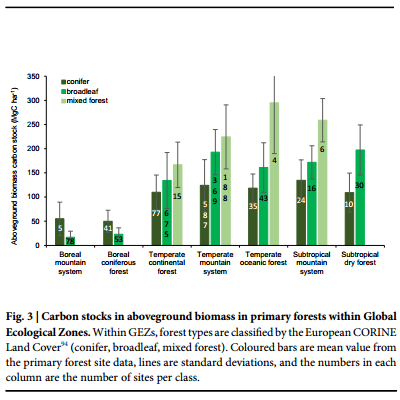Carbon accounting in the land sector requires a reference level from which to calculate past losses of carbon and potential for gains using a stock-based target. Carbon carrying capacity represented by the carbon stock in primary forests is an ecologically-based reference level that allows estimation of the mitigation potential derived from protecting and restoring forests to increase their carbon stocks. Here we measured and collated tree inventory data at primary forest sites including from research studies, literature and forest inventories (7982 sites, 288,262 trees, 27 countries) across boreal, temperate, and subtropical Global Ecological Zones within Europe. We calculated total biomass carbon stock per hectare (above- and below-ground, dead biomass) and found it was 1.6 times larger on average than modelled global maps for primary forests and 2.3 times for all forests. Large trees (diameter greater than 60 cm) accounted for 50% of biomass and are important carbon reservoirs. Carbon stock foregone by harvesting of 12–52% demonstrated the mitigation potential. Estimated carbon gain by protecting, restoring and ongoing growth of existing forests equated to 309 megatons carbon dioxide equivalents per year, additional to, and higher than, the current forest sink, and comparable to the Green Deal 2030 target for carbon dioxide removals.
The Hungarian contribution involved 590 samples of 6 forest reserves (Baktai-erdő, Fényi-erdő, Juhdöglő-völgy, Kékes, Vár-hegy, Vétyem ER) and of Györke (Transcarpathia, UA) and Tarpai Öreg-erdő (HU) to the evaluation of the temperate continental forest zone.
